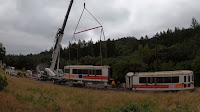UPDATE: The updated photos have been sent to our webmaster for addition to the PNAERC site, but we're always interested in recent photos of poorly covered cars, especially the ones listed here. An email at any time with photos or updates of any of this equipment is appreciated!
I need your help! As you may be aware, we were never able to get the photo upload feature on the PNAERC website working, which means I can update the
written data anytime I like but I'm unable to change, add, or remove any of the photos or videos. D'oh! But never fear - our indefatigable webmaster, Jeff Hakner, says he can upload an entire new collection of photos all at once and update everything in one fell swoop.
As such, I've been going through the entire list and trying to find recent - or recent-ish - photos of every piece of equipment, all 2,100 or so of them. This has taken quite a long time but I'm about 90% of the way there. There are, however, missing pieces - cars for which I can't find any photos at all, not even reasonably outdated ones.
That's where you come in! If you have any photos of any of the pieces of equipment listed below, and would be willing to have your photos published online to help fill out the PNAERC list (credit or not as you prefer), I'd be very grateful for any submissions. Photos should be somewhat recent (I'd prefer sometime within the last 20 years, but the main thing is that the car should look roughly the same in the photo as it does now) but do not have to be excellent quality. A dimly lit, oddly angled, or partially obscured photo is better than none. Thank you!
Edit: Many thanks to Cambridge Lutece and Wesley Paulson for sending in photos!
Alberta Prairie Railway Excursions - DL&W 4602, DL&W 4627
Boone & Scenic Valley - Metra 1538, Metra 1551
Brooks Preservation Society - DL&W 3236
Canada Science & Technology Museum - Toronto Ry 64, BCER 1235
Canadian Railway Museum - QRL&P 105, TTC TP10, MT 1801, MT 1953
Connecticut Trolley Museum - York Utilities 72
Denver Rail Heritage Society - DT 83
Edmonton Radial Railway Society - ERR 31, SMR 35, ERR 38, ERR 53, SMR 54, Calgary 60, Sask 62, ERR 65, ERR 73, LSR 202, TTC 4349
Electric Railway Historical Association, Perris, CA - LARy 34, LARy 44, SDER 201
Fort Smith Trolley Museum - FSL&T 10, CT 305, CT 310
Gomaco - basically every PCC in storage in Ida Grove, Iowa
Halton County Radial Railway - TTC 4053
La Crosse County Historical Society - MVPS 12
Middletown & Hummelstown - CTA S372, DL&W 4307
Mariazeller Museumstramway, Austria - TARS 640
McKinney Avenue Transit Authority - DR&T 183, DR&T 189, DR&T 323
Museum of the American Railroad - Metra 1548, 1585, 1608, 1652, 1661
Museum of Mobile - Mobile unk#
National Museum of Transportation - UR 165, SLPS 850
Oregon Electric Railway Historical Society - Fresno 74
Pacific Southwest Railway Museum - DL&W 3583 (aka SD&A 251)
Penn Ohio Electric Railway - PAT 1639, PAT 1728
Reading Blue Mountain & Northern - DL&W 2310 (aka RBM&N 314), DL&W 2313 (aka RBM&N 313), DL&W 2316 (aka RBM&N 312), DL&W 2341 (aka RBM&N 311)
San Diego Electric Railway Association - SDER 128
San Francisco Municipal Railway - SFMR 1115, SFMR 1130
Seashore Trolley Museum - NYSR 113, WF&O 60, MBTA 3338, MBTA 3344
South Shore Line Museum Project - CSS&SB 351
Southern California Railway Museum - LARy 807, LARy 836, LARy 1003, LARy 9007
Symco Union Thresheree, Wisconsin - CSL 1278
Travel Town - LARY 59
United Railroad Historical Society - PRR 413, PRR 453, DLW 2406, DLW 3541
Western Railway Museum - Stockton 52, Key 186, PG&E 41, IER 358, Peninsular 61
Note 1: I left private owners off this list; I also left off the collection in Windber, since it's going away soon anyway!
Note 2: It is distinctly possible that some of the cars listed here have been scrapped. If you have any information regarding cars listed here that no longer exist, please drop me a line!



















































